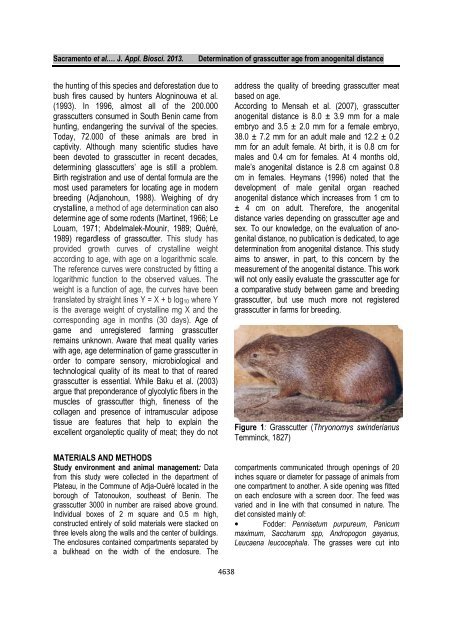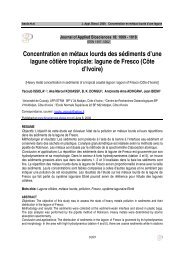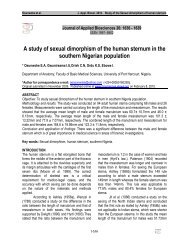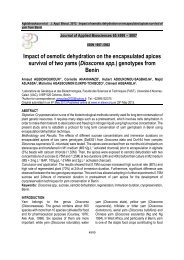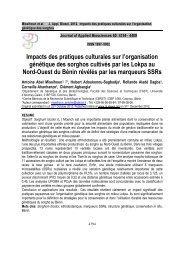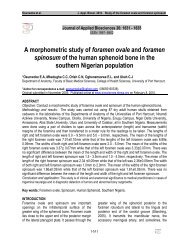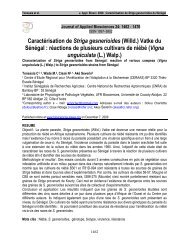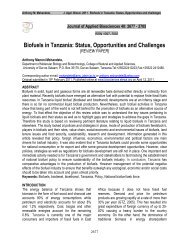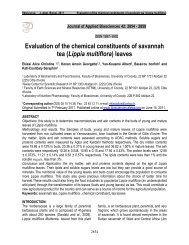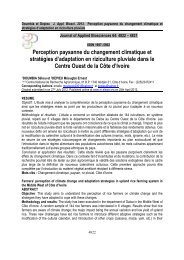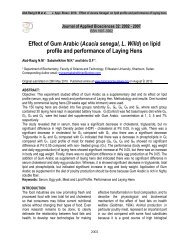Determination of grasscutter age - African Journals Online (AJOL)
Determination of grasscutter age - African Journals Online (AJOL)
Determination of grasscutter age - African Journals Online (AJOL)
You also want an ePaper? Increase the reach of your titles
YUMPU automatically turns print PDFs into web optimized ePapers that Google loves.
Sacramento et al.… J. Appl. Biosci. 2013.<strong>Determination</strong> <strong>of</strong> <strong>grasscutter</strong> <strong>age</strong> from anogenital distancethe hunting <strong>of</strong> this species and deforestation due tobush fires caused by hunters Alogninouwa et al.(1993). In 1996, almost all <strong>of</strong> the 200.000<strong>grasscutter</strong>s consumed in South Benin came fromhunting, endangering the survival <strong>of</strong> the species.Today, 72.000 <strong>of</strong> these animals are bred incaptivity. Although many scientific studies havebeen devoted to <strong>grasscutter</strong> in recent decades,determining glasscutters’ <strong>age</strong> is still a problem.Birth registration and use <strong>of</strong> dental formula are themost used parameters for locating <strong>age</strong> in modernbreeding (Adjanohoun, 1988). Weighing <strong>of</strong> drycrystalline, a method <strong>of</strong> <strong>age</strong> determination can alsodetermine <strong>age</strong> <strong>of</strong> some rodents (Martinet, 1966; LeLouarn, 1971; Abdelmalek-Mounir, 1989; Quéré,1989) regardless <strong>of</strong> <strong>grasscutter</strong>. This study hasprovided growth curves <strong>of</strong> crystalline weightaccording to <strong>age</strong>, with <strong>age</strong> on a logarithmic scale.The reference curves were constructed by fitting alogarithmic function to the observed values. Theweight is a function <strong>of</strong> <strong>age</strong>, the curves have beentranslated by straight lines Y = X + b log10 where Yis the aver<strong>age</strong> weight <strong>of</strong> crystalline mg X and thecorresponding <strong>age</strong> in months (30 days). Age <strong>of</strong>game and unregistered farming <strong>grasscutter</strong>remains unknown. Aware that meat quality varieswith <strong>age</strong>, <strong>age</strong> determination <strong>of</strong> game <strong>grasscutter</strong> inorder to compare sensory, microbiological andtechnological quality <strong>of</strong> its meat to that <strong>of</strong> reared<strong>grasscutter</strong> is essential. While Baku et al. (2003)argue that preponderance <strong>of</strong> glycolytic fibers in themuscles <strong>of</strong> <strong>grasscutter</strong> thigh, fineness <strong>of</strong> thecoll<strong>age</strong>n and presence <strong>of</strong> intramuscular adiposetissue are features that help to explain theexcellent organoleptic quality <strong>of</strong> meat; they do notMATERIALS AND METHODSStudy environment and animal man<strong>age</strong>ment: Datafrom this study were collected in the department <strong>of</strong>Plateau, in the Commune <strong>of</strong> Adja-Ouèrè located in theborough <strong>of</strong> Tatonoukon, southeast <strong>of</strong> Benin. The<strong>grasscutter</strong> 3000 in number are raised above ground.Individual boxes <strong>of</strong> 2 m square and 0.5 m high,constructed entirely <strong>of</strong> solid materials were stacked onthree levels along the walls and the center <strong>of</strong> buildings.The enclosures contained compartments separated bya bulkhead on the width <strong>of</strong> the enclosure. Theaddress the quality <strong>of</strong> breeding <strong>grasscutter</strong> meatbased on <strong>age</strong>.According to Mensah et al. (2007), <strong>grasscutter</strong>anogenital distance is 8.0 ± 3.9 mm for a maleembryo and 3.5 ± 2.0 mm for a female embryo,38.0 ± 7.2 mm for an adult male and 12.2 ± 0.2mm for an adult female. At birth, it is 0.8 cm formales and 0.4 cm for females. At 4 months old,male’s anogenital distance is 2.8 cm against 0.8cm in females. Heymans (1996) noted that thedevelopment <strong>of</strong> male genital organ reachedanogenital distance which increases from 1 cm to± 4 cm on adult. Therefore, the anogenitaldistance varies depending on <strong>grasscutter</strong> <strong>age</strong> andsex. To our knowledge, on the evaluation <strong>of</strong> anogenitaldistance, no publication is dedicated, to <strong>age</strong>determination from anogenital distance. This studyaims to answer, in part, to this concern by themeasurement <strong>of</strong> the anogenital distance. This workwill not only easily evaluate the <strong>grasscutter</strong> <strong>age</strong> fora comparative study between game and breeding<strong>grasscutter</strong>, but use much more not registered<strong>grasscutter</strong> in farms for breeding.Figure 1: Grasscutter (Thryonomys swinderianusTemminck, 1827)compartments communicated through openings <strong>of</strong> 20inches square or diameter for pass<strong>age</strong> <strong>of</strong> animals fromone compartment to another. A side opening was fittedon each enclosure with a screen door. The feed wasvaried and in line with that consumed in nature. Thediet consisted mainly <strong>of</strong>:• Fodder: Pennisetum purpureum, Panicummaximum, Saccharum spp, Andropogon gayanus,Leucaena leucocephala. The grasses were cut into4638


